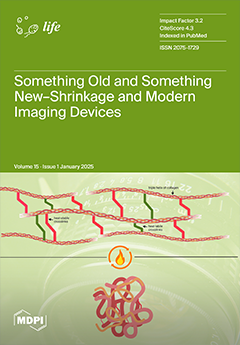This study investigates the resilience of the unicellular green microalga
Chlorella vulgaris to extreme atmospheric conditions simulating those of Mars, Jupiter, and Titan. Using Earth as a control, experiments were conducted under autotrophic and mixotrophic conditions to evaluate the organism’s photosynthetic efficiency, oxygen
[...] Read more.
This study investigates the resilience of the unicellular green microalga
Chlorella vulgaris to extreme atmospheric conditions simulating those of Mars, Jupiter, and Titan. Using Earth as a control, experiments were conducted under autotrophic and mixotrophic conditions to evaluate the organism’s photosynthetic efficiency, oxygen production, and biomass growth over 2, 5, and 12 days. Photosynthetic performance was analyzed through chlorophyll a fluorescence induction (JIP-test), metabolic activity via gas chromatography, and biomass accumulation measurements. Despite the extreme atmospheric compositions—ranging from the CO
2-rich, low-pressure Martian atmosphere to the anoxic atmospheres of Jupiter and Titan—
C. vulgaris demonstrated resilience and a functional photosynthetic apparatus, maintaining growth and oxygen production. Notably, the Martian atmosphere enhanced photosynthetic performance, with fluorescence curves and Fv/Fm ratios surpassing Earth-like conditions, likely due to elevated CO
2 and low pressure. Under mixotrophic conditions, the addition of glucose further enhanced metabolic activity and biomass growth across all atmospheres. These findings highlight the potential of
C. vulgaris for bioregenerative life support systems, enabling oxygen production, CO
2 sequestration, and resource cultivation in extraterrestrial habitats. The study showcases the organism’s adaptability to extreme environments, with implications for astrobiology, space exploration, and sustainable extraterrestrial ecosystems. These findings expand habitability criteria and explore extremophiles’ potential to support life beyond Earth.
Full article






